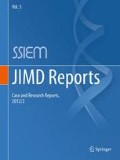Abstract
Expanded newborn screening (NBS) leads to an increased number of false positive results, causing parental anxiety, greater follow-up costs, and the need for further metabolic investigations. We developed and validated a second-tier approach for NBS of homocystinurias by measuring the total homocysteine (tHcy) on the initial dried blood spot (DBS) samples to reduce the need for further investigation, and investigated newborn DBS homocysteine values in patients with homocystinuria. Total DBS homocysteine was measured in normal newborns, and retrospectively in newborns with established disorders, using liquid chromatography tandem mass spectrometry (LC-MS/MS) with stable isotope-labelled internal standards for homocysteine. Analytes were separated using reverse phase chromatography with a total run time of 3 min. The method was linear over the range of 10–100 μmol/L of tHcy and showed excellent precision; intra-batch CV was 4% and inter-batch precision 6.5%. Comparison of 59 plasma values with DBS for tHcy taken at the same time showed excellent correlation, (r 2>0.97). The reference range for current neonatal samples was 5.4–10.7 μmol/L (n=99), and for the stored neonatal samples (stored dry, sealed in plastic at room temperature for 10 years) was 1.7–5.5 μmol/L, (n=50), both being normally distributed. The clinical utility of this method was checked by retrospective analysis of stored NBS samples from patients with different forms of homocystinuria, including four different remethylating disorders. All had clear elevations of tHcy.
Competing interests: None declared.
Access this chapter
Tax calculation will be finalised at checkout
Purchases are for personal use only
Abbreviations
- AC:
-
Acylcarnitine
- C3:
-
Propionylcarnitine
- cbl:
-
Cobalamin
- CBS:
-
Cystathionine β-synthase
- DBS:
-
Dried blood spot
- ESI-MS/MS:
-
Electrospray tandem mass spectrometry
- LC-MS/MS:
-
Liquid chromatography tandem mass spectrometry
- Met:
-
Methionine
- MS/MS:
-
Tandem mass spectrometry
- MTHFR:
-
Methylene tetrahydrofolate reductase
- NBS:
-
Newborn screening
- tHcy:
-
Total homocysteine
References
Bowron A, Barton A, Scott J, Stansbie D (2005) Blood spot homocysteine: a feasibility and stability study. Clin Chem 51:257–258
Digest I (2007) Hyperhomocysteinemia and cobalamin disorders. Mol Genet Metab 90:113–121
Fowler B (1997) Disorders of homocysteine metabolism. J Inherit Metab Dis 20:270–285
Gan-Schreier H, Kebbewar M, Fang-Hoffmann J et al (2009) Newborn population screening for classic homocystinuria by determination of total homocysteine from guthrie cards. J Pediatr 156:427–432
Gempel K, Gerbitz K-D, Casetta B, Bauer MF (2000) Rapid determination of total homocysteine in blood spots by liquid chromatography-electrospray ionization-tandem mass spectrometry. Clin Chem 46:122–123
Magera MJ, Lacey JM, Casetta B, Rinaldo P (1999) Method for the determination of total homocysteine in plasma and urine by stable isotope dilution and electrospray tandem mass spectrometry. Clin Chem 45:1517–1522
Matern D, Tortorelli S, Oglesbee D, Gavrilov D, Rinaldo P (2007) Reduction of the false-positive rate in newborn screening by implementation of MS/MS-based second-tier tests: the Mayo Clinic experience (2004–2007). J Inherit Metab Dis 30:585–592
McCann SJ, Gillingwater S, Keevil BG, Cooper DP, Morris MR (2003) Measurement of total homocysteine in plasma and blood spots using liquid chromatography-tandem mass spectrometry: comparison with the plasma Abbott IMx method. Ann Clin Biochem 40:161–165
Refsum H, Fredriksen Å, Meyer K, Ueland PM, Kase BF (2004) Birth prevalence of homocystinuria. J Pediatr 144:830–832
Schiff M, Benoist J-F, Tilea B, Royer N, Giraudier S, Ogier de Baulny H (2011) Isolated remethylation disorders: do our treatments benefit patients? J Inherit Metab Dis 34:137–45
Tortorelli S, Turgeon CT, Lim JS et al (2010) Two-tier approach to the newborn screening of methylenetetrahydrofolate reductase deficiency and other remethylation disorders with tandem mass spectrometry. J Pediatr 157:271–275
Turgeon CT, Magera MJ, Cuthbert CD et al (2010) Determination of total homocysteine, methylmalonic acid, and 2-methylcitric acid in dried blood spots by tandem mass spectrometry. Clin Chem 56:1686–1695
Whitehead VM (2006) Acquired and inherited disorders of cobalamin and folate in children. Br J Haematol 134:125–136
Wilcken B, Wiley V, Hammond J, Carpenter K (2003) Screening newborns for inborn errors of metabolism by tandem mass spectrometry. N Engl J Med 348:2304–2312
Yap S, Naughten E (1998) Homocystinuria due to cystathionine β-synthase deficiency in Ireland: 25 years' experience of a newborn screened and treated population with reference to clinical outcome and biochemical control. J Inherit Metab Dis 21:738–747
Author information
Authors and Affiliations
Corresponding author
Editor information
Editors and Affiliations
Additional information
Communicated by: Georg Hoffmann.
Appendices
Competing Interests
Nil.
Funding
This research was funded by NSW Biochemical Genetics Service.
Ethical Approval
This research was carried out within the guidelines of The Children’s Hospital at Westmead Research Ethics Committee.
Guarantor
K. Carpenter.
Contributorship
A. Alodaib conducted the method development and wrote the first draft of the manuscript. K. Carpenter supervised the project. V. Wiley and T. Wotton provided newborn screening samples and results. J. Christodoulou and B. Wilcken directed the research. All authors reviewed and edited the manuscript and approved the final version of the manuscript.
Rights and permissions
Copyright information
© 2011 SSIEM and Springer-Verlag Berlin Heidelberg
About this chapter
Cite this chapter
Alodaib, A.N., Carpenter, K., Wiley, V., Wotton, T., Christodoulou, J., Wilcken, B. (2011). Homocysteine Measurement in Dried Blood Spot for Neonatal Detection of Homocystinurias. In: JIMD Reports - Case and Research Reports, 2012/2. JIMD Reports, vol 5. Springer, Berlin, Heidelberg. https://doi.org/10.1007/8904_2011_109
Download citation
DOI: https://doi.org/10.1007/8904_2011_109
Received:
Revised:
Accepted:
Published:
Publisher Name: Springer, Berlin, Heidelberg
Print ISBN: 978-3-642-28095-5
Online ISBN: 978-3-642-28096-2
eBook Packages: Biomedical and Life SciencesBiomedical and Life Sciences (R0)

